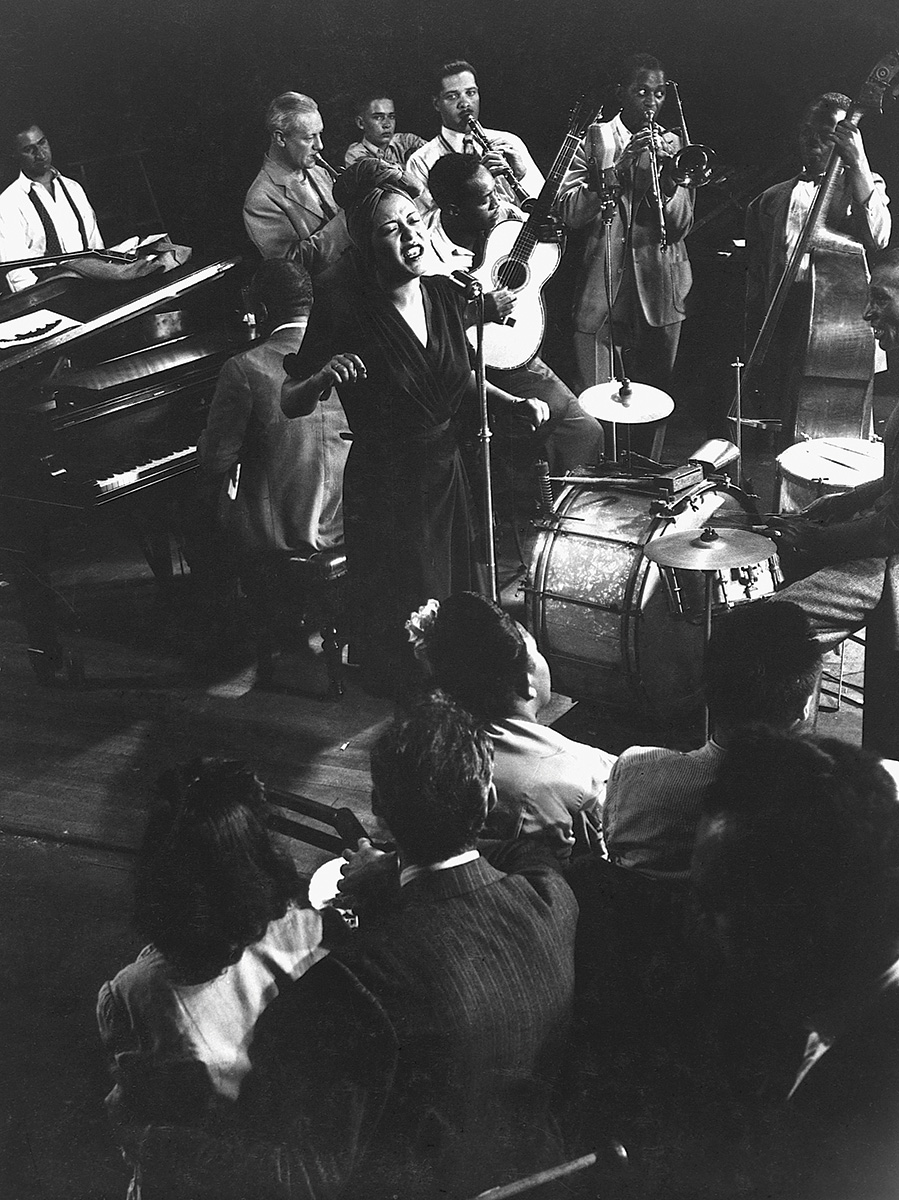Let’s grab all our pop music records - pop in a broad sense, music that is neither classical nor traditional - and bear in mind the following: everything recorded there is a legacy of the black songs of the Mississippi Delta in the transition from the 18th century to the 19th century. Everything. These were the songs that gave rise to the Blues. And the world without Blues would not be this world as we know it - and it probably wouldn't have half the beauty it has.
Let’s grab all our pop music records - pop in a broad sense, music that is neither classical nor traditional - and bear in mind the following: everything recorded there is a legacy of the black songs of the Mississippi Delta in the transition from the 18th century to the 19th century. Everything. These were the songs that gave rise to the Blues. And the world without Blues would not be this world as we know it - and it probably wouldn't have half the beauty it has.

The Blues are the basis of all popular and commercial music developed during the 20th century. Notice this: I’m not speaking of inspiration, nor of reference, here the issue is more concrete; the Blues are the basis, the musical structure on which the other genres have developed, having the most primordial (Jazz, Rhythm & Blues, Rock and Roll) derived directly from this seminal music, which deserves that we take some time contemplating it and learning its history. Finding the genesis of the Blues would require a long and deep journey through the history of slavery and, later, the time before the slave trade in sub-Saharan Africa. From the territory that is Senegal today, or Gambia, or Mali, came out the songs, scales and even the instruments that constitute the pre-history of the Blues, each one being a remote ancestor of what was born in the Southern States of the United States of America, around the great Mississippi Delta. The fertile territories where the Blues germinated, emerged and grew were cotton plantations and construction works for large infrastructures, with the North American railway line at the top. It was in these contexts that blacks, mostly slaves, chanted, while working hard, the so-called Spirituals, songs of biblical inspiration of slow and introspective rhythms, with simple, repetitive structures, usually around choruses. There were some Spirituals with more accelerated and joyful rhythms, with the so-called shout, but these usually invited festivity and leisure, included dance and rhythmic marking, sometimes with percussion, sometimes with clapping or stamping. There were still other types of songs, like work songs or the field hollers, who acted as a kind of stray that the men sang, among themselves or from each other, and that will also be at the origin of the primordial amalgam that ended up being called Blues. All of these songs were vocals and had no instrumental accompaniment. It is these black songs that constitute what we can now consider as the zero point of the Blues: the moment in time and place where the now popular genre begins to crystallize and take shape. Most likely, it is also thanks to these characteristics - the melancholy, the dragging song, the suggested contemplation - that the term blues appears associated to this genre of music. Sadness and melancholy were, at the time, often called blue devils. In the lyrics of the Blues, “to have the blues” is a popular expression that means “to be sad” or “to feel melancholic” that often appears, both in the ancestral compositions and in those of today.
Blues: the story
The first record of a Blues composition, a score in which that musical genre appears unquestionably associated to melancholy, is I Got the Blues, from 1908, by a New Orleans musician, Antonio Maggio. However, the first written reports of this type of music dates back to the beginning of the 20th century. Between 1901 and 1903, there are numerous references to this new music in the states of Mississippi, Georgia or Texas, among others. One of these accounts became particularly well known: W.C. Handy, self-proclaimed “father of the Blues” and the second artist signing a composition of the genre, The Memphis Blues, registered for copyright purposes (the first, Dallas Blues, belongs to Hart Wand, but both were registered in 1912), claimed to have had contact with the Blues for the first time during a train journey. Handy was traveling illegally in a wagon when he would have seen a black man playing a guitar using a razor - a technique similar to what is now called slide guitar. What the man played during that trip was the St. Louis Blues, popularly considered the first Blues song in History - however, this consideration should not be taken for granted, since it is impossible to identify “The first song”, not least because, as can be seen from what has been described above, the Blues are not born in one place or in one just a circumstance, they are rather a genre that is spreading in a specific territory, but at the same time vast, and in a concrete culture, but simultaneously dispersed. In this period when sound records and Blues scores already exist, the musical genre has some concrete identifiable characteristics. Before going any further, let us return to the beginning of the piece, where it is stated that everything in modern popular music originates in the Blues. In fact, there are those who disagree because they consider that Jazz has a role as important as the Blues in this primordial broth that gave rise to Rock and Roll, which, in turn, gave rise to much of what we know today. It turns out that one current, at least, argues that Jazz itself has its origins in the Blues (as opposed to another current that argues that they are “sister genres”, which would have appeared at the same time, but with different roots).
At the risk of resenting those who are for the second current, I choose to believe the first. Let us return to the characteristics of the Blues to explain the option. Blues is not just a musical genre, it is also a way of musical progression. That is, it is prior to the gender itself and its surplus. The scale of the Blues (which is repeated in Rock and Roll ad nauseam) appears in the early days of Jazz, and at that time, in the early twentieth century, there are numerous compositions that, in the light of the labels we use today, can be both Blues or Jazz, or both simultaneously. Therefore, it makes sense for Jazz to emerge from a faction of the Blues that is detached from the root and that is progressing in another direction. There is yet another detail of the greatest importance: the Blue Note. Any Jazz and Blues connoisseur will immediately associate with the old label specialized in both genres. Its name is an appropriation (legitimate, of course) of the term blue note, which appeared in the Blues, which designates a note that is not pure, that is: it is played and tuned as if it suffered an inflection that makes it melancholier, “folding it” until a lower pitch is obtained. Blue notes also exist in Jazz.
Another fundamental characteristic of the Blues is the melisma. Notoriously inherited from Spirituals, which were those religious songs from, for example, psalms, the melisma consists in the intonation of a syllable over more than one note. This technique abounds in the blues chants and it is not necessary to give it much thought to find examples, namely in the beginning of the genre, of syllables that are prolonged in the singing along several notes, as it happens in the music Soul or in contemporary R'n'B. Being the origin of the Blues exclusively vocal, the genre, as it grew, felt the need to be accompanied by something more. In the early days, an acoustic guitar served as a basis for the vocalist to sing about the characteristic Blues chord progression - in the original Blues compositions, the melody always goes up until it reaches the point of inversion, that is, the note that makes a kind reset to that melodic line, which sometimes returns to zero and sometimes gives way to a new melody, which will also work in progress. This simple way, without props, to accompany the singing was called Country Blues. The musicians, usually soloists, reinterpreted the basic melodies, which we can call standards, with total freedom and improvised stories about them and often spontaneous poetry that addressed numerous subjects, although they were almost always melancholy. In addition to the acoustic guitar, the harmonic to cut the corner and the rhythm marked by the foot on the floor are also characteristic of this more primitive phase. The rapid spread of the musical genre meant that it quickly reached some of the main North American cities, such as Memphis or Chicago. It was not long before the musicians began to perform in organized concerts. This is how the “City Blues” come alive, with a much more sophisticated musical approach and with the voices accompanied by groups of instrumentalists who played piano, guitar and usually a wind instrument (trumpet or saxophone, generally), in addition to a rhythmic section composed by percussions and double bass.
Ladies sing the blues
in this phase, that is, in the first moment of the "City Blues", we witness the phenomenon "classic blues singer". And that's when the first big names of Blues singers pop up. Yes, the classic blues singers were singers. This era is dominated by the female voices of Ma Rainey, Bessie Smith, Sippie Wallace, or Sister Rosetta Tharpe - who popped up a little later and who played the Blues in a very unique way, playing the electric guitar. Memphis Minnie, another big name at the time, was also a guitarist. Before all of them, there was Mamie Smith, the “mother of the Blues”, the first African American woman to record a Blues song, entitled Crazy Blues. Mamie Smith was a multi-talented artist. Ballerina, pianist and actress, was noted for all the reasons. She was black and a woman, but none of those qualities intimidated her. She sang, gave concerts, recorded in studios, faced a world that was not prepared for it, and became a legend. It is with Mamie Smith that everything really begins. Not in the sense that the Blues start with her, because they already existed, but rather because of the importance she had as a performer and in the definition of a style and a record. Looking at Sippie Wallace, contemporary with Smith, we can consider her equally pioneering, although she was less prominent. Despite having a short career (dhe preferred to become an organist in a church and lead a choir) she still recorded four albums, besides having signed several music compositions, such as Mighty Tight Woman, popularized in the 70s in a version of Bonnie Raitt.
Of all these women, however, none were at Bessie Smith's level - for better or worse. There are, about Bessie, countless descriptions, and it is doubtful whether any of them
lie in the “beautiful, modest and household” trinity – and if it happens, it must be ignored, as it will be the most profound lie. Temperamental, bohemian, admittedly bisexual, exaggerated and no hostage to modesty, Bessie Smith “had the mouth of a sailor”, according to academic Blues expert CC Rider, who also adds Bessie's voracious appetite for whiskey, before concluding: "The life she led would leave the wildest rock star with his chin on the ground." Amen. Her charisma, her robust voice, her ongoing revolution, were so striking that it is one of the influences most mentioned by renowned singers - as is the case of Janis Joplin who, more than 30 years after Bessie Smith’s death, paid a headstone for the singer's grave.
The weight that the other artists had in the history of Blues is due to what they represented when they showed up on the music scene. For example, Ma Rainey was the first professional African American singer. Sister Rosetta Tharpe, on the other hand, had the greatest asset in the extraordinary domain of the electric guitar. For some reason she is cited as a great influence by people as different as Elvis Presley, Jerry Lee Lewis, Little Richard, Chuck Berry or Johnny Cash. In a style that, from a certain moment on, came to be dominated by male voices (and hands, and music compositions), it is difficult to find, in the contemporary era, a diva with the dimension of these, from the beginnings. Only, perhaps, the aforementioned Bonnie Raitt, included in every “best ever” list dedicated to the Blues, or singers, or guitarists, reached a level of notoriety and similar influence. Of course, names are missing here: from Etta James to Billie Holiday, to those lesser known, but still fundamental in Blues history, like Viola McCoy.
Bluesmen
The Blues did not evolve as a solid set, all in the same direction. At the same time that the “City Blues” were consolidated with the classic divas taking over the microphone, a subgenre was taking shape, mixing the roots of the Blues with characteristics and instruments, such as mandolins, from folk coming from other places. The main difference, however, lies in the letter interpreter. In a kind of return to the origins, men took the guitars and took over the stages. Among these, the first big name and, possibly, the most influential Blues musician of all time, is Robert Johnson. It is elevated to a semi-divine condition by unavoidable musicians, like Eric Clapton, who describes it as such: "The most important Blues singer that has ever existed." Rolling Stone magazine considered Robert Johnson the fifth best guitarist of all time. Johnson's influence has, of course, to do with the period in which he pops up: the Blues were a new song and he was one of the first to gain fame within this universe that was being drawn and gaining contours. An extraordinary composer and singer, he also shone, as can be deduced, by the superlative way he played the guitar - on acoustic guitars, such as the famous Gibson L1, for example. The Johnson legend was also built on rumors, the most famous of which says he sold his soul to the devil at an intersection. For what? To gain his incredible ability to play the guitar. Robert Johnson died in 1938 at the age of 27, anticipating what would become, decades later, a kind of tragic trait with a touch of coolness: being a music star and dying at 27.
Two years before Robert Johnson's death, another of the most important Blues names was born: Muddy Waters. McKinley Morganfield was his birth name and marked history for being one of the precursors of the Blues with electric guitar, such as BB King. Being musicians of the same generation, they immortalized the genre through electricity. Muddy Waters also added the permanent percussion in the drums, something that, on a trip to England in the 50s, would leave influences sown throughout the country, to the point that the Rolling Stones had an indispensable reference in the musician. And BB King is... BB King. For many, he is confused with the Blues themselves, he is the incarnation of this music born in the Mississippi delta, only clinging to a beautiful electric guitar to die for called Lucille. BB King is simply essential for the Blues and for all contemporary popular music. BB King was called Riley Ben King, actually. BB meant just one thing: Blues Boy. Probably one of the most suitable nicknames of the history of the Blues. After this, others came, like Eric Clapton, of course, to add their pages to the vast History of that black music from the mines, the railways and cotton fields. However, the fundamental chapters, these, were written by those of whom we speak about here.
Most popular
.jpg)

Relacionados
.jpg)
.jpg)




